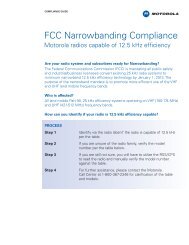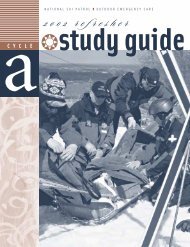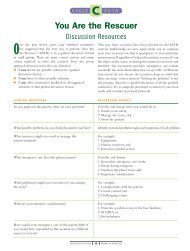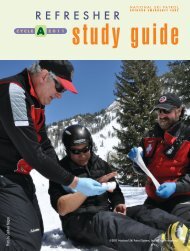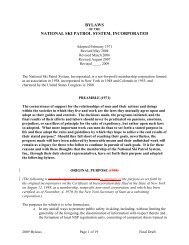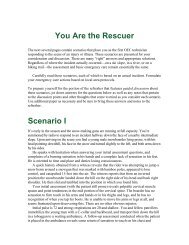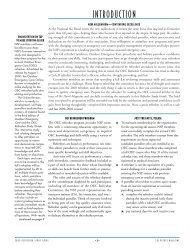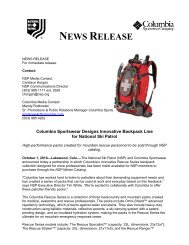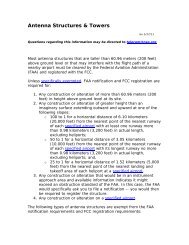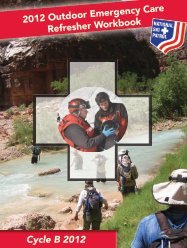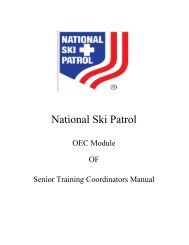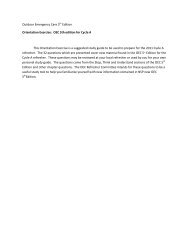Sierra Samaritans - National Ski Patrol
Sierra Samaritans - National Ski Patrol
Sierra Samaritans - National Ski Patrol
Create successful ePaper yourself
Turn your PDF publications into a flip-book with our unique Google optimized e-Paper software.
photo 5<br />
PHOTOS BY LLOYD MULLER<br />
Quarter Hop, start<br />
❚ CONTINUED FROM PAGE 31<br />
experience is an injury or your legs giving<br />
out while you travel down the mountain.<br />
Strength work is fundamental for injury<br />
prevention. For example, it is very important<br />
to keep the quadriceps strong so that<br />
the knee stays in place.<br />
Wall Sit<br />
For this exercise you’ll need an exercise<br />
ball like those found at most gyms and<br />
training facilities. You can also purchase<br />
them at fitness shops or retail outlets.<br />
Place the ball between the small of your<br />
back and a solid wall and place your feet<br />
in front of you so you’re leaning back<br />
slightly (photo 7). Begin to squat into a<br />
seated position and allow the ball to travel<br />
up your back. Sink down slowly until<br />
you’re in a seated position with your knees<br />
at a 90-degree angle. Be sure you don’t<br />
bend so far that your knees are in front of<br />
your toes. Hold the seated position for a<br />
couple seconds and then rise slowly until<br />
you’re standing upright, but do not take a<br />
break at the top.<br />
Initially do this up and down for 12<br />
repetitions. When this exercise gets easier<br />
as your strength improves, start holding<br />
photo 6<br />
Quarter Hop, hop<br />
the seated position for longer periods: 5,<br />
10, 15, 20, and 30 seconds. This exercise<br />
builds strength in the glutes and the core<br />
stabilizer muscles. As the knee flexes and<br />
extends, the quads work to hold it in position.<br />
This exercise helps you build<br />
endurance for a day in the bumps, and the<br />
use of the ball improves balance because<br />
the exercise is then performed in a relatively<br />
dynamic format.<br />
Upper Body Strength and Balance<br />
Do basic bicep curls or tricep presses<br />
while standing on one leg. Not only will<br />
this help you build upper body strength in<br />
your arms, chest, and back, it will require<br />
you to tighten your core muscles while<br />
also working on stability. The movement<br />
If you snowboard you’ll often need to rotate your upper body in order<br />
to ride switch. Having a strong core and upper body<br />
will keep you from over-rotating and losing your balance.<br />
of the weight and your upper body will<br />
challenge your lower body to stay balanced.<br />
Your core muscles will tighten to<br />
keep you from bending over at the waist<br />
or losing your balance.<br />
If you snowboard you’ll often need to<br />
rotate your upper body in order to ride<br />
switch. Having a strong core and upper<br />
body will keep you from over-rotating and<br />
losing your balance. When you’re ready for<br />
a bigger challenge, try these exercises while<br />
photo 7<br />
Wall Sit<br />
standing on a Bosu® (a popular balancetraining<br />
device that’s essentially an inflated<br />
dome on one side and a flat rubber platform<br />
on the other.)<br />
MACHINES<br />
The following strength exercises call for<br />
using weight machines. They are all performed<br />
with one leg at a time to help condition<br />
the legs for independent action on<br />
the slopes. However, it’s important to<br />
build both legs up to equal strength.<br />
Everyone has a naturally dominant<br />
side that will be a bit stronger than the<br />
other, but if the ratio becomes too great,<br />
the body will become unstable, making<br />
balance even more difficult. Although<br />
these exercises are performed in seated or<br />
prone positions that don’t present balance<br />
challenges, strengthening and toning<br />
these muscles will improve overall muscular<br />
stability in variable terrain, which can’t<br />
help but aid balance.<br />
Single-leg Press<br />
This exercise can be done on almost any<br />
leg press equipment and is particularly<br />
well-suited to a seated leg-press machine,<br />
as shown in photo 8. However, a proneposition<br />
machine will also work. The benefit<br />
of the seated machine is that it keeps<br />
stress off the spine. This exercise is not<br />
recommended for squat equipment, such<br />
as the angled hack squat machine.<br />
32 <strong>Ski</strong> <strong>Patrol</strong> Magazine | Winter 2005



